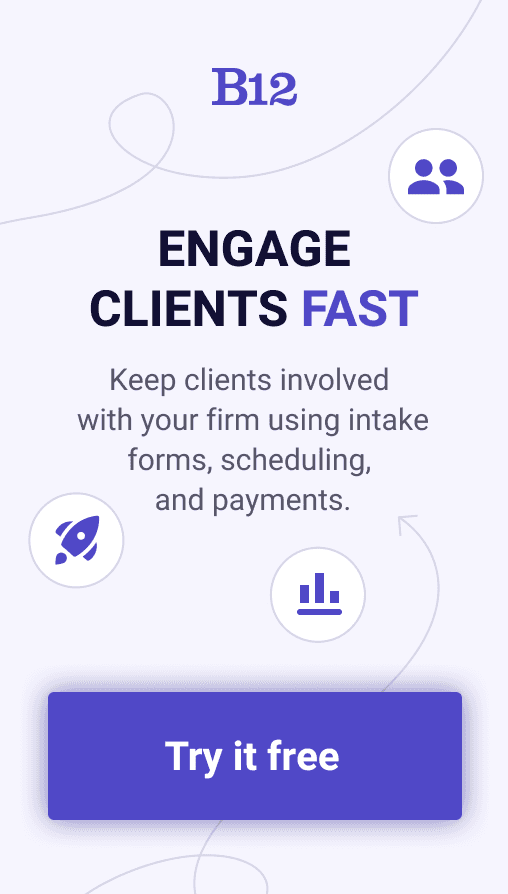Build an AI website in 60 seconds
AI generates your personalized website instantly with built-in scheduling, payments, email marketing, and more.
Start for free
What do the best landing pages have in common?

Landing pages play a vital role in converting potential customers into loyal ones. A landing page is a standalone web page designed to receive and convert traffic. The importance of optimizing your landing pages can’t be overstated, as it can increase your conversion rates, drive sales, and boost your ROI. In fact, if you have more than ten high-quality landing pages, you can get 55% more leads than those without.
Read on to discover the key components of a great landing page. We’ll also provide tips on how to test and analyze your own landing pages for optimal conversion.
Importance of having the best landing page
Landing pages are essential in any content marketing campaign. They serve as the gateway that visitors pass through before they make a purchase, sign up for a newsletter, or download a free trial. A high-converting landing page can help increase your conversion rate, generate leads or sales, and grow your business. On the other hand, a poorly designed sales landing page can turn away potential customers and harm your branding efforts.
To create high-converting landing pages, you need attention to detail and a deep understanding of your target market. The best landing page examples always include copy that resonates with audiences. Moreover, they feature visuals that reinforce your message, are easy to navigate, and engage visitors. By creating landing pages that convert, you'll be able to generate leads, increase sales, and achieve your business goals.
Clear and compelling headlines
The headline is the first thing a visitor notices when they land on a website. And you know what? That’s the very reason it’s the most critical element of a landing page. An effective headline is clear and concise. It summarizes the content of the page in just a few words. It should be eye-catching enough to grab the visitor's attention and entice them to stay and explore the page. A boring or confusing headline can quickly turn off visitors, resulting in high bounce rates and low conversion rates.
To create a clear and compelling headline, it's important to identify the main benefit or value proposition of the product or service you’re offering. So how do you do this? Start by understanding the needs and pain points of your target audience and highlighting how your product/service can solve their problems. Use simple language and avoid industry jargon as well so that the headline is easy to understand and resonates with the audience.
A good headline should also accurately reflect the content on the landing page. If the headline promises one thing but the content delivers something else, it can result in high bounce rates and a negative user experience. A common mistake is using clickbait-style headlines that mislead website visitors into clicking through to the page. While this may initially drive traffic, it ultimately leads to low engagement and low conversion rates.
By taking the time to craft an effective headline, businesses can improve the performance of their landing pages and drive more conversions.
Relevant and valuable content
When crafting a great landing page, it's crucial to focus on more than just its aesthetics. Yes, having an attractive landing page design and strong imagery is important. However, the content remains an irreplaceable component of every great landing page.
At its core, a typical landing page is designed to convert visitors into leads or customers, and this can only be achieved by providing them with relevant and valuable information addressing their needs or wants. Visitors click on landing pages to learn more about your product or service. And unless you provide them with relevant information, they are unlikely to stick around for very long.
A good landing page example is one that focuses on your unique value proposition as a business. It should highlight the benefits and features that differentiate you from your competitors. Craft your content while keeping your audience and their needs in mind. More importantly, highlight the awe-inspiring benefits that prospects can gain from signing up for your offer.
Another critical aspect of content that can make or break a landing page is its relevance. An effective landing page should speak directly to the visitor's specific pain point or concern. Doing so involves identifying and understanding your target audience and tailoring your message to resonate with them. By understanding your visitors’ challenges and providing solutions in your content, you can build trust and ultimately provide them with the information they need to make a decision on your offer.
To keep your visitors from bouncing, your own landing page should have valuable content. Every time a visitor lands on your page, you want to make sure they leave transformed in some way. You can do this by offering downloadable resources, tips, industry news, or access to exclusive information. By giving your visitors valuable information, they will keep coming back for more, increasing your lead generation efforts.
Engaging visuals and design
Visuals and design play a crucial role in creating the best landing page. The key is to remember that visuals should complement the content rather than overpower it. They should be used strategically to break up the text and make the page visually appealing. So remember to use relevant images, video testimonials for social proof, infographics, and other forms of multimedia. Additionally, consider adding a hero image or a hero shot to further entice your target audience. But the entire page shouldn't just be text and visuals. In this case, make sure to use white space strategically to help declutter the text.
The landing page design should also be consistent with your company’s overall branding. The colors, typography, and layout should reflect the brand’s personality and style. What’s more, you should prioritize making the design simple and uncluttered. Too much information or too many design elements can be overwhelming and confusing for visitors.
You should also consider where to place your call-to-action (CTA) buttons. The CTA button should be prominently placed and stand out from the rest of the page. The color, text, and design of the button should compel the visitor to take action. Additionally, the page should have a clear hierarchy of information, with the most important elements placed above the fold.
Don’t forget to optimize your landing page for mobile devices. With more and more people accessing the internet through their mobile devices, a mobile-friendly landing page is a must. The design and layout should adapt to the smaller screen size, and the page should load quickly. A slow-loading page can lead to high bounce rates and lost potential customers. By optimizing for mobile, you can ensure that you’re not missing out on a significant portion of the audience.
Strong call to actions
Your landing page shouldn’t be missing a strong call to action. This is the element that prompts the user to take action, whether it ‘s to make a purchase, sign up for a newsletter, or simply request more information. Your CTA should be clear, concise, and attractive. Use strong action words and highlight the value proposition, which is what the user will gain by taking the desired action.
It's important to consider the placement of your CTA as well. While it's standard practice to feature it prominently above the fold, oftentimes, it can be effective to include multiple CTAs throughout the page. You can consider putting it within the body of the content and even at the bottom of the page. This ensures that users see the CTA at different points during their visit, increasing the likelihood of conversion.
Another aspect to consider is the CTA’s design. A visually appealing button or link can attract the user's attention and drive them toward the desired action. So make sure to carefully choose the CTA’s colors, text, and overall aesthetic. You should also consider the size of the button or link. You want it to be large enough to be noticed. But it shouldn’t be so large that it's overwhelming or causes the user to have to scroll excessively to view the rest of the page.
Lastly, don't be afraid to experiment and test different CTAs. This will help you see which ones perform the best. A/B testing allows you to create multiple versions of a landing page, each with a different CTA inviting users to take action. Afterward, you can monitor the performance of each to determine which one yields the highest conversion rate. By continually refining and improving your CTA, you can ensure that your best landing pages are always optimized for success.
Optimized for conversion: testing and analyzing your best landing pages
To optimize your landing pages for conversions, make sure to test and analyze them continuously. You can never know for sure what will work for your audience if you don’t test your pages. And that's why A/B testing is an excellent way to analyze and compare conversion rates. Testing helps you evaluate your landing pages' effectiveness based on different metrics. This can include click-through rates, conversions, and bounce rates. You can test varying elements on your landing pages, including headlines, visuals, call-to-actions, copy, layout, and more.
While running an A/B test, identify your key metrics. These will help you determine how you can best improve your performance. Set a benchmark for measuring progress to evaluate changes in success over time. When doing this, it's important to take a data-driven approach and try solutions the data supports. This will help you know which element contributed to the improved conversion rates.
In addition to testing, it's essential to analyze the data gathered, including traffic sources, conversion rates, and user behavior, to determine which landing page elements significantly impact conversion. With this data, you can formulate an effective plan to optimize various on-page elements that aren't converting, such as call to actions, forms, or headlines.
Furthermore, you’ll be able to see which parts of the landing page users spend their time on, which ones seem to confuse them, and where they exit the page. All these insights can help you adjust your focus and improve your overall conversion rate.
Ultimately, testing and analyzing your landing pages are continuous processes that require attention and adjustment to achieve consistent success. Best practices for optimizing pages differ by audience and industry. It's crucial to measure the endpoint of each test you carry out, so you know how it's affected your progress toward your goals.
Build better landing pages with B12
Are you a business owner who needs help improving and scaling your business? B12 is the all-in-one platform that enables you to look professional online and reach new clients. Our professional web designers, copywriters, and SEO specialists ensure your web pages are set up for conversion, a strong first impression, and retention. With B12’s powerful solutions, you can generate a professional landing page that converts leads and increases your service sales without compromising your brand identity. Get started for free.
Attract, win, and serve more clients
Receive helpful resources directly to your inbox to help you succeed online.
Draft your site in 60 seconds
Get an AI website made specifically for you that's free to launch.
Start for free ✨No credit card required
Related posts
Spend less time on your website and more time growing your business
Let B12 set up your professional online presence with everything you need to attract, win, and serve clients.





